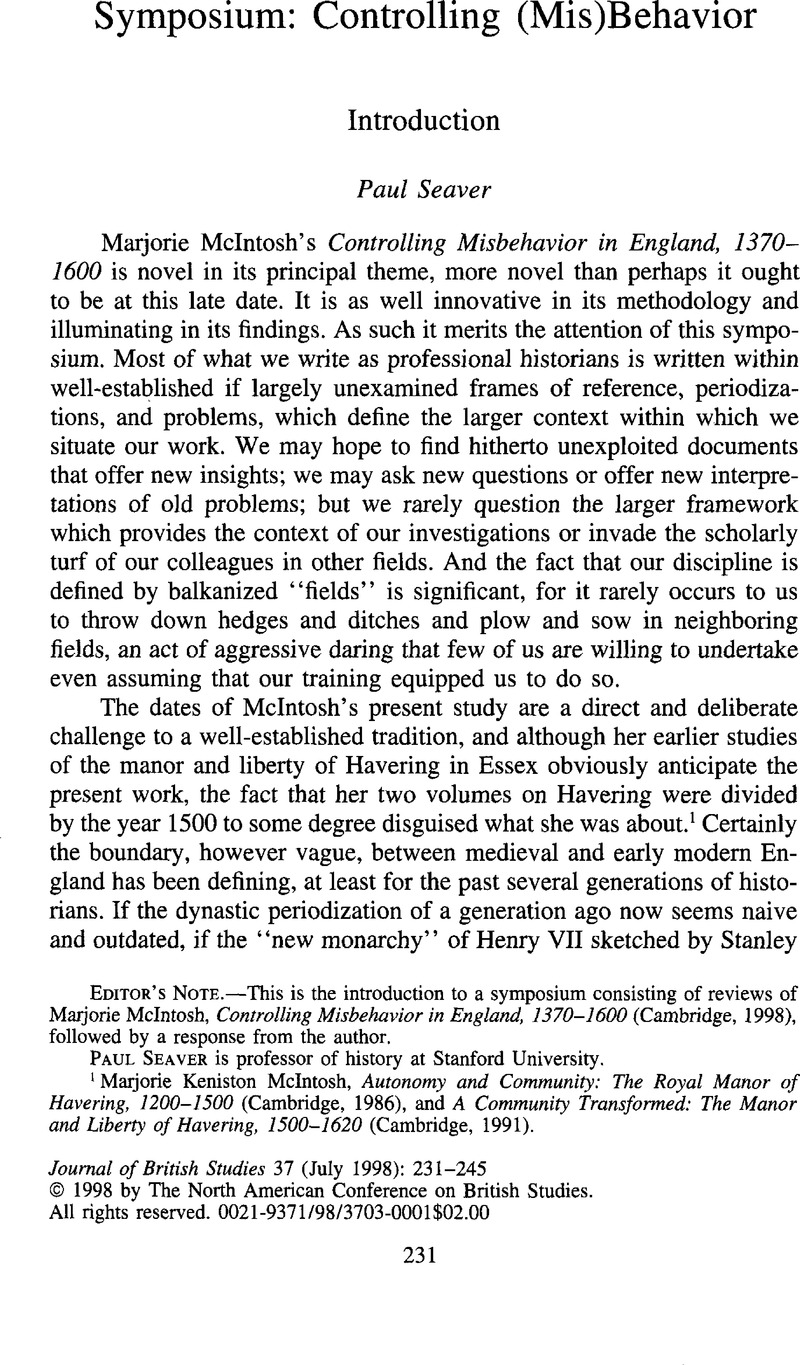Article contents
“Good Governance” in the Medieval and Early Modern Context
Published online by Cambridge University Press: 10 January 2014
Abstract

- Type
- Symposium: Controlling (Mis)Behavior
- Information
- Journal of British Studies , Volume 37 , Issue 3: Controlling (Mis)Behavior: Medieval and Early Modern Perspectives , July 1998 , pp. 246 - 257
- Copyright
- Copyright © North American Conference of British Studies 1998
References
1 Harrison, William, Harrison's Description of England in Shakespere's Youth, ed. Furnivall, Frederick J., New Shakespeare Society, ser. 6, no. 1 (London, 1887), pp. 134–35Google Scholar.
2 McIntosh, Marjorie K., “Finding Language for Misconduct: Jurors in Fifteenth-Century Local Courts,” in Bodies and Disciplines: The Intersection of Literature and History in Fifteenth-Century England, ed. Hanawalt, Barbara A. and Wallace, David (Minneapolis, 1996), pp. 87–122Google Scholar.
3 Gauvard, Claude, “De grâce especial”: Crime, ètat et société en France à la fin du moyen âge, 2 vols. (Paris, 1991)Google Scholar.
4 “The Boke of Nurture folowyng Englondis gise by John Russell,” in The Babee's Book: Medieval Manners for the Young, ed. Furnivall, Frederick J. (London, 1923), pp. 47–50Google Scholar.
5 Razi, Zvi, Life, Marriage, and Death in the Medieval Parish: Economy, Society, and Demography in Halesowen, 1270–1400 (Cambridge, 1980)Google Scholar.
6 Raftis, J. Ambrose, Tenure and Mobility: Studies in the Social History of the Medieval English Village (Toronto, 1965), pp. 103–4Google Scholar, Warboys: Two Hundred Years in the Life of an English Medieval Village (Toronto, 1974), pp. 216–17Google Scholar, and “Changes in an English Village after the Black Death,” Mediaeval Studies 29 (1967): 158–77Google Scholar. DeWindt, Edwin, Land and People in Holywell-cum-Needingworth: Structures of Tenure and Patterns of Social Organization in an East Midlands Village, 1252–1457 (Toronto, 1972), p. 244Google Scholar.
7 DeWindt, , Land and People in Holywell-cum-Needingworth, pp. 270–75Google Scholar.
8 Raftis, , Warboys, pp. 217–24Google Scholar. Poos, L. R. in A Rural Society after the Black Death: Essex, 1350–1525 (Cambridge, 1991), pp. 231–62Google Scholar, discusses both the group rebellions and the individual acts of rebellion in Essex. This county, of course, saw the beginning of the Revolt of 1381 as well as episodes of Oldcastle's revolt (1413–14) and Cade's rebellion (1450).
9 Britton, Edward, The Community of the Vill: A Study in the History of the Family and Village Life in Fourteenth-Century England (Toronto, 1977), pp. 103–23Google Scholar.
10 Hanawalt, Barbara A., Crime and Conflict in English Communities, 1300–1348 (Cambridge, Mass., 1979), pp. 252–53Google Scholar.
11 Hanawalt, Barbara A., “Community Conflict and Social Control: Crime and Justice in the Ramsey Abbey Villages,” Mediaeval Studies 39 (1977): 402–23CrossRefGoogle Scholar.
12 Olson, Sherri, A Chronicle of All That Happens: Voices from the Village Court in Medieval England (Toronto, 1996), pp. 162–205Google Scholar.
13 Blanchard, Ian, “Social Structure and Social Organization in an English Village at the Close of the Middle Ages: Chewton, 1526,” in The Salt of Common Life: Individuality and Choice in the Medieval Town, Countryside, and Church, ed. DeWindt, Edwin Brezette (Kalamazoo, Mich., 1995), pp. 307–39Google Scholar.
14 Britton, , The Community of the Vill, pp. 33–37, 40–51Google Scholar.
15 Bennett, Judith M., Women in the Medieval English Countryside: Gender and Household in Brigstock before the Plague (New York, 1987)Google Scholar.
16 Olson, , Chronicle of All That Happens, p. 215Google Scholar.
- 3
- Cited by


